Nissan Leaf 2023 Review
The 2023 Nissan Leaf is a milestone in the world of electric cars.
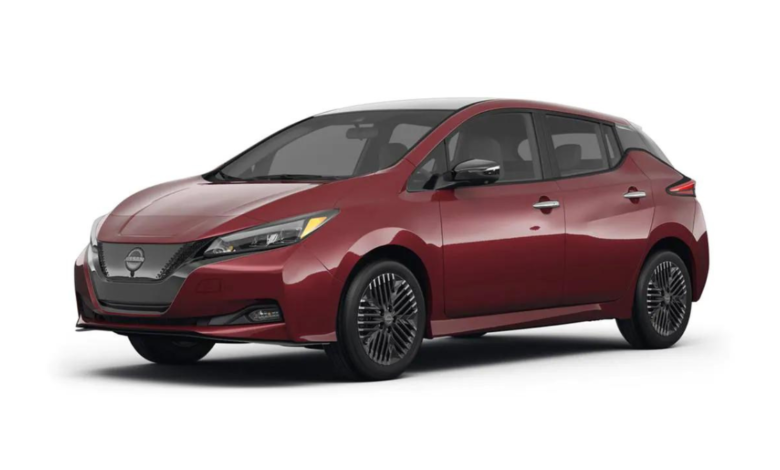
Although the Nissan Leaf had a significant revamp in 2018, the long-standing electric vehicle (EV) received exterior enhancements in 2023, revitalizing the rather lacklustre hatchback small sedan. Although the range remains limited, the revised product offerings simplify decision-making for those seeking an electric vehicle suitable for families and homes in urban and suburban areas with convenient access to charging infrastructure.
The 2023 selection is reduced to only the basic Leaf S and top SV Plus after a 2022 price cut. Every model has a redesigned front end with a new headlamp design, modified grille, and front bumper. Thankfully, the chrome lining is now black, and the blue deflectors are black. The vehicle’s interior and outside have new Nissan badging, but the SV Plus, with its 17-inch aluminium alloy wheels with five spokes, has the most apparent modification.
The Leaf pioneered the current EV’s development, although its significance has since faded. The Hyundai Kona Electric, Kia Niro EV, and Chevrolet Bolt EV all have comparable (or better) pricing points in their class, but they provide more, particularly regarding range. Although the front seats of the Leaf feel roomy and comfortable, the cargo area in the other hatchbacks is superior.
The five-passenger hatchback comes in two trim levels with two different powerplant options. The Essential Leaf costs $29,135 (plus a $1,095 delivery charge) and has an electric motor with a horsepower of 147 and a 40 kWh battery pack with a maximum range of 149 miles. With a reduced 60 kWh battery pack and a more powerful 214 hp electric motor, the Leaf SV Plus can go 212 miles between charges. However, the starting price differential is also significant at $37,135.
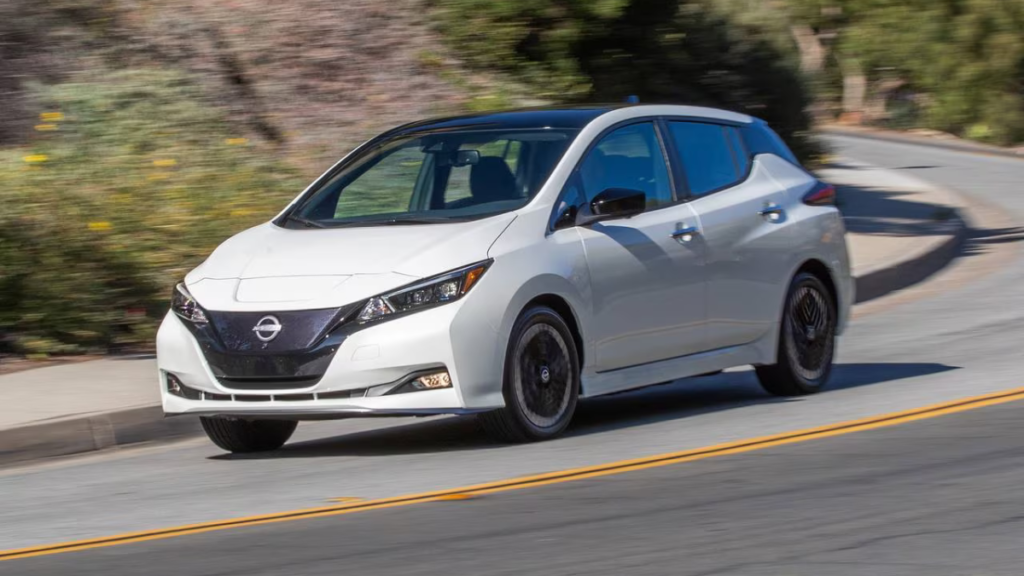
While the Bolt EV’s driving characteristics are more immediate, the Leaf has a more tranquil, well-balanced ride for everyday commuters. It’s a relatively smooth ride. There are never any noises or a sense that the suspension is unduly pressured. Even though it is about to become obsolete, the CHAdeMO quick-charging connector is still functional. Beyond the increased range, the top-tier SV Plus model comes equipped with Nissan’s ProPilot Assist advanced driving mode, one of the many luxury amenities that justifies the additional price.
Amid an abundance of EVs with cutting-edge designs and longer-range estimates, like Nissan’s own Ariya, it is easy to write off the Leaf as an outdated relic. However, it still provides a potent blend of comfort, reliable technology, and range at an appealing price. It’s too bad the top-trim SV Plus isn’t eligible for federal tax credits; with the $7,500 savings, it would be a straightforward buy. Nevertheless, the Leaf is surprisingly affordable and dependable, where so many EVs are straying into luxury areas.
What’s New
- Streamlined lineup pared down to S and SV Plus
- updated costs and lineup
- The new grille design and front bumper give the front end a makeover.
- Black headlights have replaced the chrome ones.
- New 17-inch aluminium five-spoke wheels are fitted on SV Plus.
- The wind deflectors are not blue; they are black.
- revised tire deflectors
- Nissan’s new logo
- There are seven hues: Deep Blue Pearl, Gun Metallic, Brilliant Silver Metallic, and Super Black. On the S, Glacier White is available. Only the SV Plus is offered in Scarlet Ember Tintcoat, Pearl White Tricoat, and one two-tone Pearl White Tricoat/Super Black.
- fresh decals on the steering wheel
- The SV Plus’s 62 kWh battery pack is reduced to 60 kWh for increased efficiency.
Pros & Cons
Pros
- The spacious cargo hold and throughout, considering the small footprint
- Improved looks with front-end changes and simplified trim levels
- The infotainment screen and other tech look (and are) up-to-date
Cons
- The CHAdeMO charging connecter is almost obsolete
- Maximum 212-mile range meagre for the segment
- The base is too minimal, with a small battery and an even lower range
Performance: Nissan Leaf
The two available powerplant options for the 2023 Leaf are the Essential Leaf S and the higher SV Plus. The Leaf SV Plus has a more powerful electric motor that produces 214 horsepower, 250 pounds of torque, and a 60 kWh battery combination. The S employs an electric motor rated at 147 horsepower and 236 pound-feet of torque, along with a 40 kWh battery pack. The Leaf is brought up to date with the Plus drivetrain.
It’s hardly surprising that the S can reach 60 mph in 7.5 seconds for an electric vehicle. Still, considering the Leaf’s usually uninteresting nature, it’s good to know it can be a little mischievous.
Although it’s not a sports vehicle, driving this one is also not excruciating. It is limited to front-wheel drive exclusively. Regular, Eco-Mode, and B-mode are the three driving modes that alter how it regenerates energy when braking. The SV Plus now has 17-inch aluminium wheels with five spokes for a new appearance.
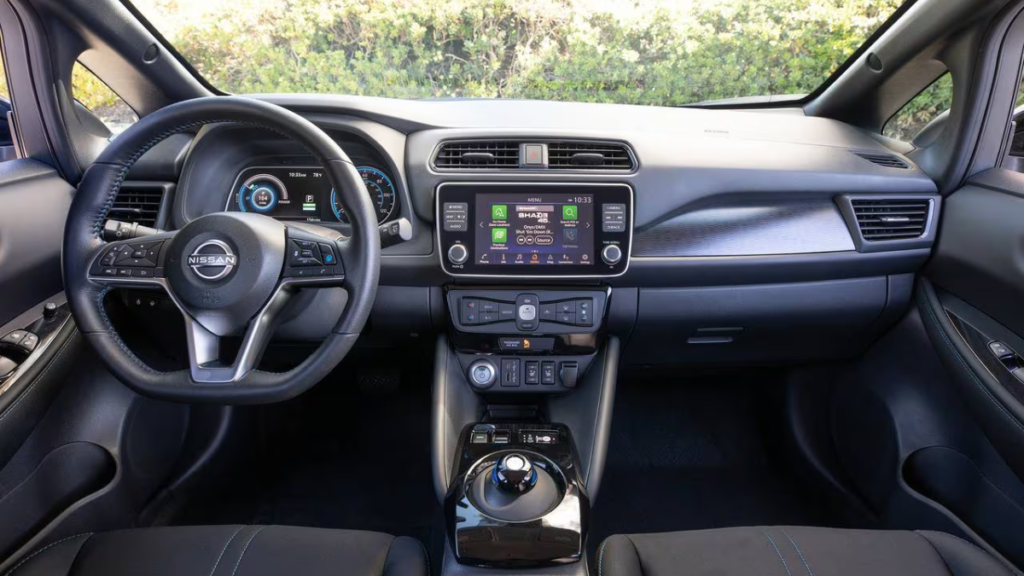
Power Consumption, Charging, and Range:
The combined average for the 2023 Leaf is an enhanced 110 MPGe thanks to the somewhat reduced battery pack on the SV Plus trim (62 kWh lowers to 60 kWh) and the modest 40 kWh pack on the basic S. The lighter S gets 111 MPGe combined, while the SV Plus gets 109 MPGe.
The Leaf is the weakest member of the competitive set, but not by much. Compared to the Bolt EV’s 28 kWh, it consumes 31 kWh of energy every 100 miles.
The Eco-Mode, which optimizes throttle responses and software for the best economy, is necessary to get the most miles per kW out of the Leaf. Additionally, a one-pedal driving option (B-mode) maximizes the energy recovered when braking.
The EPA states that the basic range is just 149 miles. However, the SV Plus has a range of 212 miles. These are among the lowest figures for electric vehicles, particularly for a sedan of this size. With 259 miles, the Bolt EV also excels in this area—but only for the base model.
The Leaf strangely insists on using the CHAdeMO charging method when it comes to charging. The optional charging mechanism appears even more antiquated in light of the broad adoption of Tesla’s North American Charging Standard (NACS) (it is located next to a standard Level 1 or 2 charge connector). It will become outdated shortly. On a Level 2 system, the 6.6 kW onboard charger can be recharged in around 11.5 hours. Nissan claims that the Plus requires an hour to reach 80% charge, whereas the S needs 40 minutes.
Driver assistance and safety:
With ten standard airbags, including side-impact head and lower bags for the backseat occupants, the Leaf takes safety very seriously. Automatic emergency braking, reverse automatic emergency braking, blind spot warning, rear cross-traffic warning, and lane-keeping assistance are all part of Nissan’s standard Safety Shield 360 package. Adaptive cruise control is available on the SV Plus. The SV Plus is equipped with the ProPilot Assist advanced driving technology as standard, simplifying driving on highways.
The Leaf has a five-star National Highway Traffic Safety Administration (NHTSA) rating. The Insurance Institute for Highway Safety (IIHS) gave the Leaf “Good” ratings in the head, side, and moderate overlap front, rear, and seat tests. Notably, the IIHS rated its child seat anchors as “Marginal” since it thought they were difficult to reach because they were positioned deep inside the cushions.
Coziness & Space: Nissan Leaf
The Leaf, for all its notoriety, is surprisingly welcoming. The front seats are large, flexible, and somewhat supportive, particularly in the top version. Despite the hatch, there is decent sight, and the rear seems open; the hatchback may be helpful. Front legroom is 42.1 inches, 44.3 inches for the Bolt EV and 41.5 inches for the Niro and Kona.
With 33.5 inches of legroom in the back, there is fierce competition. With 36.01 inches, the Bolt EV is impressive; the Kona has 33.4 inches, and the Niro has 36.9 inches, which makes it the best. Therefore, even if it’s not the most excellent rear seat, it’s still helpful and suitable for kids and quick travels.
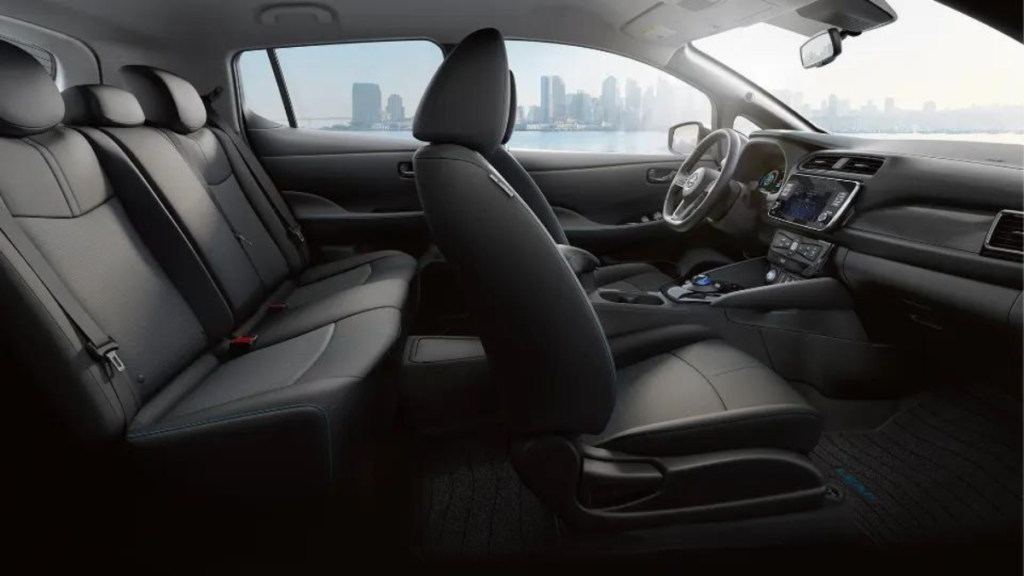
Infotainment: Nissan Leaf
An 8-inch infotainment touch panel with several connection options, including Apple CarPlay and Android Auto integration, is available on all Leaf variants. Nissan Connect software provides a logical architecture and control over operations, along with the conventional four speakers (six in the SV Plus) and digital instrument panel, which gives the driver many choices for viewing data related to range, charging, energy regeneration, and other essential factors that make driving an EV enjoyable, four USB ports are available.
We like the infotainment screen’s redundant physical power, volume, and tuning knobs. When you approach a drive-through or toll booth, it makes sense to go for the dash, even if simple steering wheel controls exist for the same purposes.
Storage & Cargo Space:
When folded, the cargo area of the Leaf is 30 cubic feet, compared to 23.6 cubic feet behind the second row. However, be aware that the second row leaves a ridge that might make pushing or sliding heavy objects ahead more challenging when folded entirely flat. It is thus less roomy with the seats down, even if it seems like a colossal hatchback.
In terms of the competition, it’s a mixed bag. Just 16.6 cubes are provided below the second row by the Bolt EV, but when folded, it can hold 57 cubes. Comparable in size, the Kona measures 19.2 and 45.8 cubes, respectively. While folded down, the Niro expands to have an impressive 63.7 cubes, yet it still plays a similar game with a comparable 22.8 cubic feet while seated.
Because of the semicircular hatch entrance on the Leaf, loading bulkier or heavier square objects may be more challenging. For convenient access, a bag that fastens to the driver’s side of the cargo area holds the provided Level 1 and Level 2 charging cords.
Regretfully, the Leaf lacks a front trunk or frunk; nonetheless, the charging connections are located on the front end. That isn’t the same.
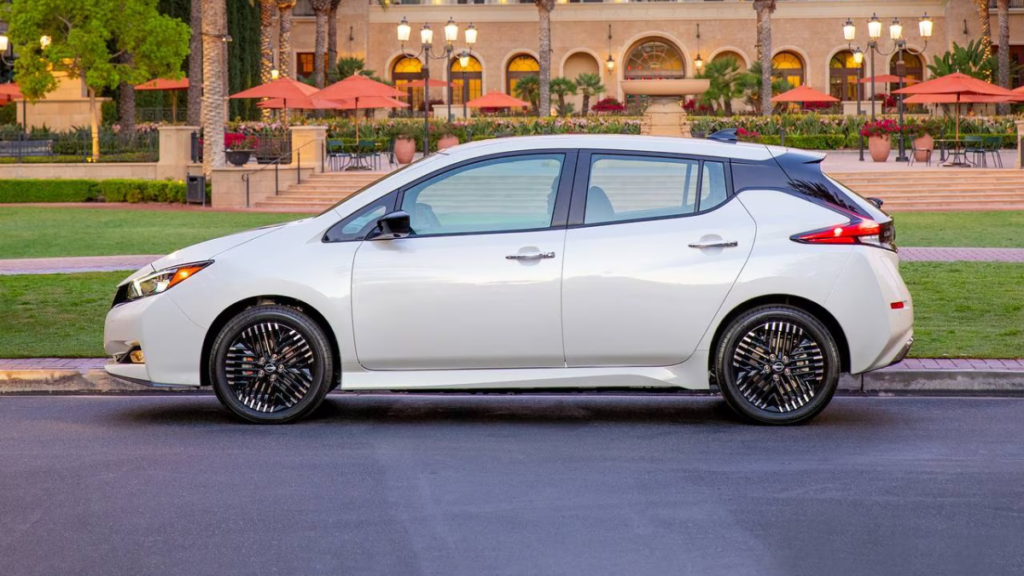
Design: Nissan Leaf
The 2023 Leaf receives a few visual upgrades, mainly to the front end, but not enough to completely erase the geeky appearance that dates back to its early EV days. Eventually, several stylistic oddities are eliminated, such as the haphazard blue line and the front end’s heterogeneous materials (everything is now black).
It’s not a very attractive car, but it seems to be a typical small hatchback, which most people desire. It still sticks out even after all these years, even if it isn’t blatantly “ELECTRIC!” Although the colour choices—including expensive ones like Pearl White Tricoat, Scarlet Ember Tintcoat, and two-tone Pearl White Tricoat with Super Black—aren’t eye-catching, they are appropriate for this kind of vehicle.
It has a robust, dependable engine and an 8-inch futuristic-looking yet manageable display inside. The tiny details of this year’s redesign include a new emblem on the steering wheel and a movie that plays when the vehicle begins. Standard black cotton material has a lovely appearance. While the SV Plus features gloss black finishers, the S has grey ones.
Is the 2023 Nissan Leaf Worth it?
Reduced to just two trim levels, the basic model’s starting price of $29,135 (plus the $1,095 delivery charge) is alluring, but its 149-mile range is too short, mainly if this is the primary car for your family. With its 40 kWh battery and 236 pound-feet of torque, it is also underpowered.
We are forced to suggest the more expensive $37,135 Leaf SV Plus. It is equipped with a more significant 60 kWh battery, a more powerful engine, a 212-mile range, and every known improvement, including motorized seating adjustments, heated exterior mirrors, fog lights, more speakers, more infotainment choices, and more sophisticated safety systems like Intelligent Cruise Control.
Thankfully, the 2022 price reductions have continued despite a few minor adjustments. Regretfully, after April 18, buyers of new 2023 Leaf vehicles are no longer eligible for the $7,500 federal tax credit. However, if you purchased the 2023 model at the start of the year, the updated qualifying standards significantly reduced the price.
How Much Does Nissan Leaf Insurance Cost 2023?
Compared to other tiny EVs, the insurance cost for the 2023 Nissan Leaf is comparatively lower. The average yearly premium for a 30-year-old female driver with a spotless record is around $2,350, which applies to all 50 states. In contrast, the Chevrolet Bolt EV costs $2,067, the Hyundai Kona Electric costs $1,888, and the Kia Niro EV costs $2,135
Nissan LEAF Generations
Second Generation
2018 to Present
For the 2018 model year, a wholly redesigned Leaf debuted with a more significant 40 kWh battery with a 149-mile range and more traditional style. With a bigger 62 kWh battery pack and a more powerful 160 kW motor with 214 horsepower, 250 pound-feet of torque, and a potential 215-mile range, the Leaf Plus entered the lineup for 2020. The Leaf reduced the number of models in its inventory to only the S and SV Plus for 2023. Its new, smaller 60 kWh battery pack improves efficiency but results in a slightly shorter 212-mile range. Some front-end adjustments changed the look.
First Generation
2010 to 2017
For the 2011 model year, the Nissan Leaf made its début in late 2010. The first Leaf design had “frog eyes” up front and a soft, bulbous shape that was not very popular. A 24 kWh battery pack with a range of 74 to 84 miles was included with the first Leaf. In 2016, the field was increased to 107 miles with an optional 30 kWh battery pack.
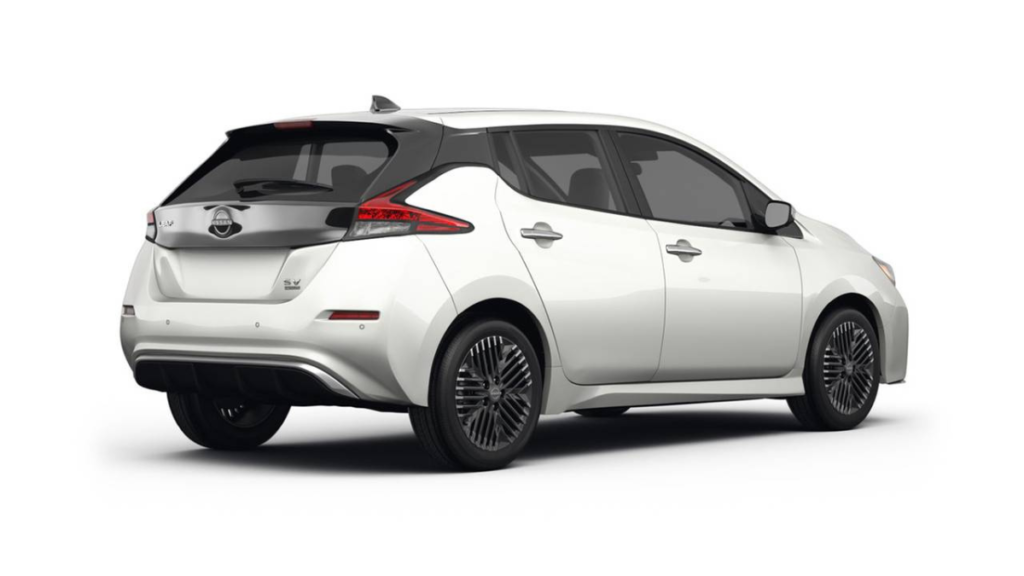
Verdict
The news that the 2023 Nissan Leaf has few alterations will reassure early adopters of EVs. Although the Leaf’s front-end design and new materials, colours, and stylish top-trim wheels have been revised, it still looks better than the long-running hatchback. It still has the unimpressive EV design from its significant 2018 redesign. Nissan has made it simpler to choose which trim to purchase: the S, which is entry-level and only has a 40 kWh battery that can go 149 miles, or the SV Plus, which is more expensive but has a 60 kWh battery that can go 212 miles. Even if the price tag of less than $30,000 is tempting, it’s a simple choice. The Leaf lags behind other small EVs, and Nissan’s Ariya is a superior option. However, the Leaf is still available (along with CHAdeMO charging) if you’re looking for a reasonably priced little hatchback.




